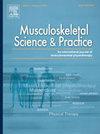Promoting longus colli muscle activation: Force direction in sitting matters
IF 2.2
3区 医学
Q1 REHABILITATION
引用次数: 0
Abstract
Background
There is limited evidence to inform exercise prescription for deep neck flexor activation out of supine.
Objective
To compare activation of longus colli (LC) and sternocleidomastoid (SCM) from supine to sitting, and to compare the effect of craniocervical flexion (CCF) exercises in sitting on activation.
Methods
Twenty-four individuals without neck pain (mean age 28.8 years, 12 females) completed 7 isometric CCF exercises (1 supine CCF, 6 sitting with applied head resistance through an elastic band in straight or oblique planes from the contra- or ipsilateral sides) while muscle activation was captured using ultrasound imaging. A 2-way analysis of variance examined the effects of exercise and muscle on percent change activation using planned post-hoc comparisons and Cohen's D to establish effect sizes.
Results
Supine CCF was equivocal to sitting CCF with resistance for LC activation (p = 0.758). The LC muscle was most robustly activated by applying an ipsilateral oblique resistance force compared to a straight lateral force (p = 0.002, Cohen's d = −0.82). LC activation was higher when oblique resistance was applied from the ipsilateral than contralateral side (p = 0.002, Cohen's d = −0.84). SCM activation was higher resisting an ipsilateral lateral force compared to a contralateral force (p = 0.0006, Cohen's d = 1.06).
Conclusions
Craniocervical flexion in supine and sitting activate LC equally but in sitting, applying oblique resistance during lateral flexion with extension enhances LC activation most effectively. Care should be taken with straight laterally applied forces since this can promote unwanted SCM activation.
求助全文
约1分钟内获得全文
求助全文
来源期刊

Musculoskeletal Science and Practice
Health Professions-Physical Therapy, Sports Therapy and Rehabilitation
CiteScore
4.10
自引率
8.70%
发文量
152
审稿时长
48 days
期刊介绍:
Musculoskeletal Science & Practice, international journal of musculoskeletal physiotherapy, is a peer-reviewed international journal (previously Manual Therapy), publishing high quality original research, review and Masterclass articles that contribute to improving the clinical understanding of appropriate care processes for musculoskeletal disorders. The journal publishes articles that influence or add to the body of evidence on diagnostic and therapeutic processes, patient centered care, guidelines for musculoskeletal therapeutics and theoretical models that support developments in assessment, diagnosis, clinical reasoning and interventions.
 求助内容:
求助内容: 应助结果提醒方式:
应助结果提醒方式:


